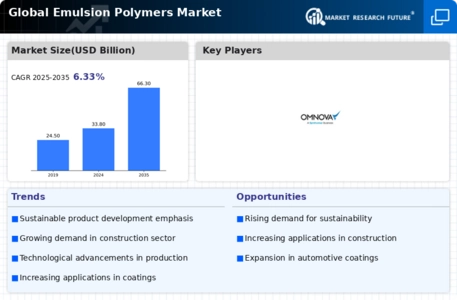Top Industry Leaders in the Emulsion Polymers Market

Emulsion Polymers Market
Strategies for Market Dominance:
-
Product Diversification: Leading players like Dow and BASF are expanding their portfolios to cater to specific end-use applications. This includes developing bio-based and low VOC emulsions for eco-conscious consumers. -
Regional Expansion: Asia-Pacific, a hotbed of construction and infrastructure development, is witnessing aggressive expansion by multinationals like Wacker Chemie and Shin-Etsu Chemical. -
Vertical Integration: Companies like Arkema are integrating backwards to secure raw material supply and control production costs. This enhances their competitiveness and resilience to price fluctuations. -
Technological Innovation: R&D is paramount, with players like DSM investing in novel emulsion technologies that offer superior performance, durability, and sustainability. -
Strategic Partnerships: Collaborations and acquisitions are frequent, allowing companies to leverage each other's strengths and access new markets. For instance, Evonik Industries partnered with China's CNPC to establish a production facility in China.
Factors Dictating Market Share:
-
Product Type: Acrylic emulsions dominate the market, followed by vinyl and styrene-butadiene (SB) latex. Each type caters to specific needs, with acrylics favored for their versatility and durability in paints and coatings. -
Application: The construction industry is the largest consumer, followed by the paper and non-woven fabrics industries. The growth of these sectors directly impacts market share distribution. -
Region: Asia-Pacific, with its rapid urbanization and booming construction activities, is the fastest-growing market. North America and Europe, though mature markets, still hold significant shares. -
Sustainability: The rising demand for eco-friendly products is driving the development of bio-based and low VOC emulsions. Companies with strong offerings in this segment gain an edge.
Key Companies in the emulsion polymers market include
- Celanese Corporation (U.S)
- BASF SE (Germany)
- The Dow Chemical Company (U.S)
- Arkema Co. (France)
- Koninklijke DSM N.V. (Netherlands)
- DIC Corporation (Japan)
- Trinsea Co. (U.S)
- Wacker Chemie AG (Germany)
- Omnova Solutions Inc. (U.S)
- Nuplex Industries Ltd (Australia)
Recent Developments:
A thermoreversible fluorescent polymer hydrogel was developed by Suzuki in December 2021. In the journal Polymers, this latest research discloses that the company used its connecting polymer technique to produce sequence conjugated polymers (CPs) that fluoresce in blue, green, and red. In addition, this process also led to the formation of matching CPs from reprecipitated Pdots with controlled alkyl moiety surface of Pdot.
It produces and supplies a range of products, which includes petrochemicals, catalysts, nutrition products, coatings, monomers, intermediates, and construction chemicals, among others.
It is involved in the chemical manufacturing business. Solvay operates through advanced formulations, advanced materials, performance chemicals, and functional polymers. The industries where its products are applicable include aerospace/aviation, automotive & transport equipment sector, electronics & electrical equipment industry, packaging; pharmaceutical sector health care sector oil & gas refining and marketing communications wire and cable semiconductors.









